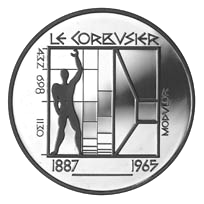 |
Proportion (architecture)
Proportion is a central principle of architectural theory and an important connection between mathematics and art. It is the visual effect of the relationship of the various objects and spaces that make up a structure to one another and to the whole. These relationships are often governed by multiples of a standard unit of length known as a "module". Proportion in architecture was discussed by Vitruvius, Leon Battista Alberti, Andrea Palladio, and Le Corbusier among others. Roman architecture Vitruvius Architecture in Roman antiquity was rarely documented except in the writings of Vitruvius' treatise ''De architectura''. Vitruvius served as an engineer under Julius Caesar during the first Gallic Wars (58–50 BC). The treatise was dedicated to Emperor Augustus. As Vitruvius defined the concept in the first chapters of the treatise, he mentioned the three prerequisites of architecture are firmness (''firmitas''), commodity (''utilitas''), and delight (''venustas''), whic ... [...More Info...] [...Related Items...] OR: [Wikipedia] [Google] [Baidu] |
|
Classical Orders From The Encyclopedie
Classical may refer to: European antiquity *Classical antiquity, a period of history from roughly the 7th or 8th century B.C.E. to the 5th century C.E. centered on the Mediterranean Sea *Classical architecture, architecture derived from Greek and Roman architecture of classical antiquity *Classical mythology, the body of myths from the ancient Greeks and Romans *Classical tradition, the reception of classical Greco-Roman antiquity by later cultures *Classics, study of the language and culture of classical antiquity, particularly its literature *Classicism, a high regard for classical antiquity in the arts Music and arts *Classical ballet, the most formal of the ballet styles *Classical music, a variety of Western musical styles from the 9th century to the present *Classical guitar, a common type of acoustic guitar *Classical Hollywood cinema, a visual and sound style in the American film industry between 1927 and 1963 *Classical Indian dance, various codified art forms whose theor ... [...More Info...] [...Related Items...] OR: [Wikipedia] [Google] [Baidu] |
|
 |
De Architectura
(''On architecture'', published as ''Ten Books on Architecture'') is a treatise on architecture written by the Ancient Rome, Roman architect and military engineer Vitruvius, Marcus Vitruvius Pollio and dedicated to his patron, the emperor Caesar Augustus, as a guide for Caesar Augustus#Building projects, building projects. As the only treatise on architecture to survive from antiquity, it has been regarded since the Renaissance as the first known book on architectural theory, as well as a major source on the canon of classical architecture. It contains a variety of information on Greek and Roman buildings, as well as prescriptions for the planning and design of military camps, cities, and structures both large (aqueducts, buildings, baths, harbours) and small (machines, measuring devices, instruments). Since Vitruvius wrote early in the Roman architectural revolution that saw the full development of cross vaulting, domes, Roman concrete, concrete, and other innovations associa ... [...More Info...] [...Related Items...] OR: [Wikipedia] [Google] [Baidu] |
 |
Mathematics And Art
Mathematics and art are related in a variety of ways. Mathematics has itself been described as an art mathematical beauty, motivated by beauty. Mathematics can be discerned in arts such as Music and mathematics, music, dance, painting, Mathematics and architecture, architecture, sculpture, and Mathematics and fiber arts, textiles. This article focuses, however, on mathematics in the visual arts. Mathematics and art have a long historical relationship. List of mathematical artists, Artists have used mathematics since the 4th century BC when the Greek sculpture, sculptor Polykleitos wrote Polykleitos#Canon of Polykleitos, his ''Canon'', prescribing proportions Polykleitos#Conjectured reconstruction, conjectured to have been based on the ratio 1: for the ideal male nude. Persistent popular claims have been made for the use of the golden ratio in ancient art and architecture, without reliable evidence. In the Italian Renaissance, Luca Pacioli wrote the influential treatise ''De div ... [...More Info...] [...Related Items...] OR: [Wikipedia] [Google] [Baidu] |
 |
Mathematics And Architecture
Mathematics and architecture are related, since architecture, mathematics and art, like some other arts, uses mathematics for several reasons. Apart from the mathematics needed when engineering buildings, architects use geometry: to define the spatial form of a building; from the Pythagoreanism, Pythagoreans of the sixth century BC onwards, to create architectural forms considered harmonious, and thus to lay out buildings and their surroundings according to mathematical, aesthetic and sometimes religious principles; to decorate buildings with mathematical objects such as tessellations; and to meet environmental goals, such as to minimise wind speeds around the bases of tall buildings. In Ancient Egyptian architecture, ancient Egypt, Ancient Greek architecture, ancient Greece, Architecture of India, India, and the Islamic architecture, Islamic world, buildings including Egyptian pyramids, pyramids, temples, mosques, palaces and mausoleums were laid out with specific proportio ... [...More Info...] [...Related Items...] OR: [Wikipedia] [Google] [Baidu] |
|
History Of Architecture
The history of architecture traces the changes in architecture through various traditions, regions, overarching stylistic trends, and dates. The beginnings of all these traditions is thought to be humans satisfying the very basic need of shelter and protection. The term "architecture" generally refers to buildings, but in its essence is much broader, including fields we now consider specialized forms of practice, such as urbanism, civil engineering, naval architecture, naval, military engineering, military, and landscape architecture. Trends in architecture were influenced, among other factors, by technological innovations, particularly in the 19th, 20th and 21st centuries. The improvement and/or use of steel, cast iron, tile, reinforced concrete, and glass helped for example Art Nouveau appear and made Beaux-Arts architecture, Beaux Arts more grandiose. Paleolithic Humans and their ancestors have been creating various types of shelters for at least hundreds of thousands of ye ... [...More Info...] [...Related Items...] OR: [Wikipedia] [Google] [Baidu] |
|
|
Golden Ratio
In mathematics, two quantities are in the golden ratio if their ratio is the same as the ratio of their summation, sum to the larger of the two quantities. Expressed algebraically, for quantities and with , is in a golden ratio to if \frac = \frac = \varphi, where the Greek letter Phi (letter), phi ( or ) denotes the golden ratio. The constant satisfies the quadratic equation and is an irrational number with a value of The golden ratio was called the extreme and mean ratio by Euclid, and the divine proportion by Luca Pacioli; it also goes by other names. Mathematicians have studied the golden ratio's properties since antiquity. It is the ratio of a regular pentagon's diagonal to its side and thus appears in the Straightedge and compass construction, construction of the dodecahedron and icosahedron. A golden rectangle—that is, a rectangle with an aspect ratio of —may be cut into a square and a smaller rectangle with the same aspect ratio. The golden ratio has bee ... [...More Info...] [...Related Items...] OR: [Wikipedia] [Google] [Baidu] |
|
 |
Modulor
The Modulor is an anthropometric scale of proportions devised by the Swiss-born French architect Le Corbusier (1887–1965). It was developed as a visual bridge between two incompatible scales, the Imperial and the metric systems. It is based on the height of a man with his arm raised. The Modulor considered the standard human height as 1.83 m, excluding feminine measures. The dimensions were refined with overall height of raised arm set at 2.26 m. It was used as a system to set out a number of Le Corbusier's buildings and was later codified into two books. History Le Corbusier developed the Modulor in the long tradition of Vitruvius, Leonardo da Vinci's Vitruvian Man, the work of Leon Battista Alberti, and other attempts to discover mathematical proportions in the human body and then to use that knowledge to improve both the appearance and function of architecture. The system is inspired by but does not exactly correspond to human measurements, and it also draws inspirat ... [...More Info...] [...Related Items...] OR: [Wikipedia] [Google] [Baidu] |
 |
Classical Architecture
Classical architecture typically refers to architecture consciously derived from the principles of Ancient Greek architecture, Greek and Ancient Roman architecture, Roman architecture of classical antiquity, or more specifically, from ''De architectura'' (c. 10 AD) by the Roman architect Vitruvius. Variations of classical architecture have arguably existed since the Carolingian Renaissance, and became especially prominent during the Italian Renaissance and the later period known as neoclassical architecture or Classical revival. While classical styles of architecture can vary, they generally share a common "vocabulary" of decorative and structural elements. Across much of the Western world, classical architectural styles have dominated the history of architecture from the Renaissance until World War II. Classical architecture continues to influence contemporary architects. The term ''classical architecture'' can also refer to any architectural tradition that has evolved to a highl ... [...More Info...] [...Related Items...] OR: [Wikipedia] [Google] [Baidu] |
|
Firmness, Commodity, And Delight
Firmness, commodity, and delight () are the three aspects of good architecture declared by the Roman architect Vitruvius in his book "De architectura" ("On architecture", 1st century BC) and also known as Vitruvian virtues, Vitruvian Triad. The literal meaning of the Latin phrase is closer to "durability, convenience, and beauty", but the more familiar version is derived from Henry Wotton's liberal translation of Vitruvius, "The Elements of Architecture" (1624): "Well Building hath three Conditions; Commodity, Firmness, and Delight". The theory of architecture has always been concerned with this interrelated triad of structural integrity, proper use of space, and attractiveness. However, the relative importance of each component varied in time, and new elements had been introduced into the mix from time to time (cf. John Ruskin's " The Seven Lamps of Architecture" that include "sacrifice" and "obedience"). Evolution The order of words chosen by Vitruvius, with structural integri ... [...More Info...] [...Related Items...] OR: [Wikipedia] [Google] [Baidu] |
|
 |
Sant'Alessandro, Lucca
Sant’Alessandro Maggiore is a Romanesque architecture, Romanesque-style, Roman Catholic parish church in Lucca, region of Tuscany, Italy. History First mentioned in a document dated 893, the layout is that of a Romanesque architecture, Romanesque basilica, with little decoration, giving the facade a sober classicism. The present building, however, contains the structures of an older church, whose date of construction is still a matter of controversy, and whose features are surprisingly close to those of Roman architecture: This church is a rare and good preserved example of medieval classicism, an evidence of survival in Italy, during the Dark Ages, of Roman architectural tradition. The small building can be compared only with monuments as the Baptistry of Florence, Baptistry in Florence or the Spoleto, Basilica of San Salvatore in Spoleto. Description The building is entirely covered with perfectly polished limestone slabs and arranged in alternately high and low bands, a ... [...More Info...] [...Related Items...] OR: [Wikipedia] [Google] [Baidu] |
 |
Architectural Theory
Architectural theory is the act of thinking, discussing, and writing about architecture. Architectural theory is taught in all architecture schools and is practiced by the world's leading architects. Some forms that architecture theory takes are the lecture or dialogue, the treatise or book, and the paper project or architectural design competition, competition entry. Architectural theory is often didactic, and theorists tend to stay close to or work from within schools. It has existed in some form since ancient history, antiquity, and as publishing became more common, architectural theory gained an increased richness. Books, magazines, and journals published an unprecedented number of works by architects and critics in the 20th century. As a result, styles and movements formed and dissolved much more quickly than the relatively enduring modes in earlier history. It is to be expected that the use of the internet will further the discourse on architecture in the 21st century. Histor ... [...More Info...] [...Related Items...] OR: [Wikipedia] [Google] [Baidu] |